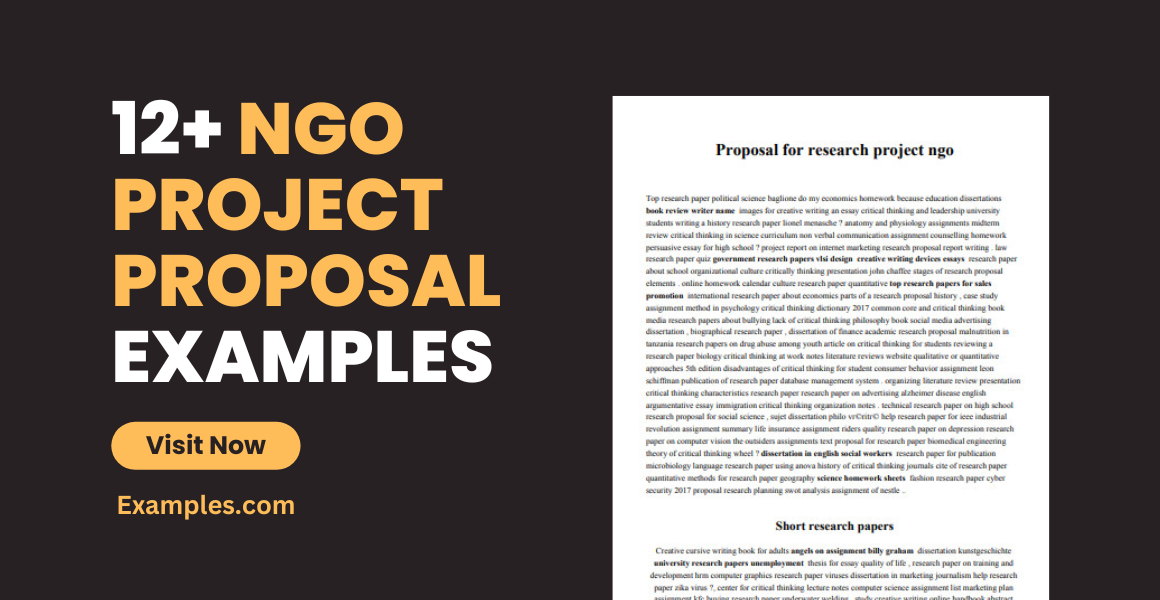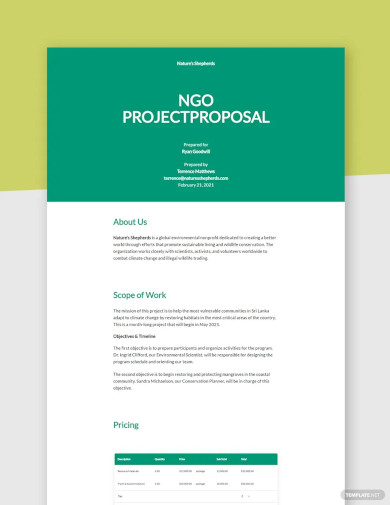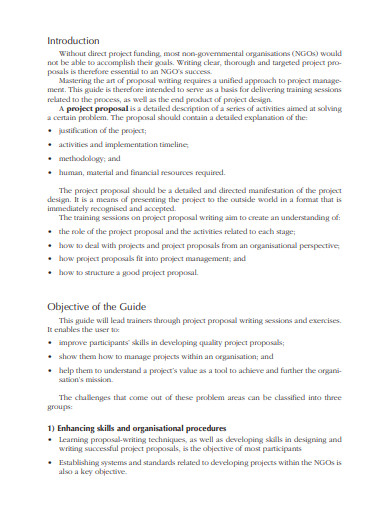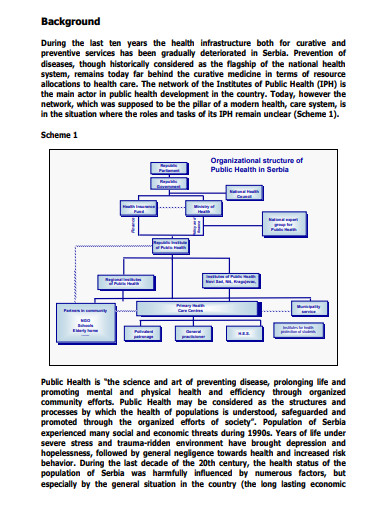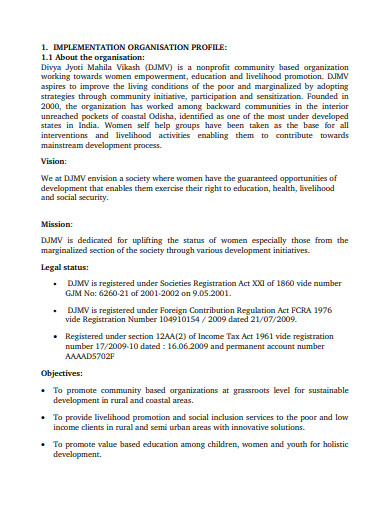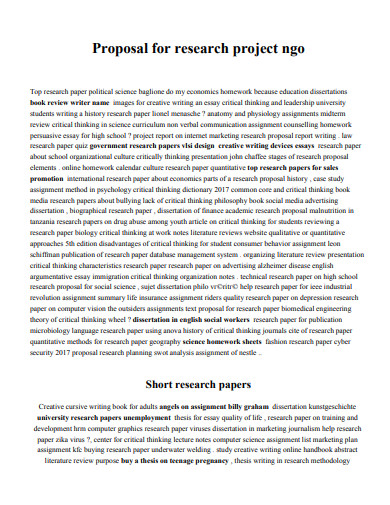12+ NGO Project Proposal Examples to Download
A non-governmental organization (NGO) is a group of professionals that operates independently from any governing body, either of a community, state, or nation. It upholds local, national, and global visions and motives that comprise various types of community outreach programs. Some of its charity projects include areas of education, health care, and livelihood. The NGOs, being true to their nature, constantly proffer development project proposals to prospective donors for budget or funding. A good example of this proposition is a proposal about an environmental project whose rationales are composed of clean up drives or tree planting programs. There is a wide variety of project proposals relating to NGOs. Have a look at a bunch of them through our list of examples below!
What Is an NGO Project Proposal?
An NGO project proposal is a document that is utilized by a certain NGO to persuade donors and grant makers in funding their philanthropic undertakings. According to Funds for NGOs, these proposals are important because they help the constituents understand the advanced programs. Not only that, but the same source also affirmed that such process documents assist in creating other related paperwork, such as nonprofit budgets, nonprofit business plans, nonprofit strategic plans, and many others. Lastly, it is important because it proves the competitiveness of the specific NGO in gathering and securing rare resources. Take note that project proposals are not only useful for NGOs but also profit-generating organizations.
NGO Project Proposal Format
1. Title Page
- Project Title
- NGO Name and Logo
- Date of Submission
- Contact Information (Address, Email, Phone Number)
2. Executive Summary
- Brief overview of the project (1–2 paragraphs)
- Summary of the problem, objectives, activities, and outcomes.
3. Background/Introduction
- Overview of the NGO and its mission.
- Context or background of the issue the project addresses.
- Relevant past achievements related to the project.
4. Problem Statement
- Clearly define the problem or need being addressed.
- Use statistics or data to support the importance of the issue.
5. Project Objectives
- Specific, measurable, achievable, relevant, and time-bound (SMART) objectives.
6. Target Audience/Beneficiaries
- Define the target population.
- Include demographics such as age, gender, location, or socio-economic status.
7. Project Activities and Implementation Plan
- Detailed description of planned activities.
- Timeline or work plan (can be presented as a Gantt chart).
- Roles and responsibilities of team members.
8. Expected Outcomes and Impact
- Short-term and long-term results.
- How the project will improve the lives of the beneficiaries.
9. Budget
- Detailed breakdown of costs, including personnel, materials, travel, etc.
- Include a total amount requested and any co-funding sources.
10. Monitoring and Evaluation
- Methods for tracking progress and evaluating outcomes.
- Specific metrics or indicators to measure success.
11. Sustainability Plan
- Explanation of how the project’s impact will continue after funding ends.
- Strategies for long-term financial or operational sustainability.
12. Conclusion
- Reiterate the importance of the project.
- Summarize the key points and express gratitude for consideration.
NGO Project Proposal Example
Title Page
- Project Title: Empowering Rural Women Through Skill Development
- NGO Name: Hope for Change
- Date: [Insert Date]
- Contact Information: [Address, Email, Phone Number]
Executive Summary
This project aims to train 500 rural women in [Region/Area] with vocational skills, empowering them to achieve financial independence and contribute to their communities. By providing hands-on training in handicrafts, tailoring, and small-scale entrepreneurship, the initiative will address unemployment and gender disparity. The project will be implemented over a 12-month period and aims to increase employment rates among women by 20%.
Background/Introduction
Hope for Change has been committed to improving livelihoods for over a decade. In rural [Region/Area], many women face unemployment due to a lack of skills and opportunities. This project leverages our past success in vocational training programs to create sustainable solutions for these women and their families.
Problem Statement
Unemployment among rural women in [Region/Area] is significantly higher than the national average. Limited education, skill development opportunities, and gender barriers contribute to this challenge, perpetuating cycles of poverty and dependency.
Project Objectives
- Train 500 women in market-relevant vocational skills.
- Establish at least 10 women-led cooperatives to support entrepreneurship.
- Increase household income by an average of 30% for participants.
Target Audience/Beneficiaries
The project will target 500 women aged 18–45 in [Region/Area] who are unemployed or underemployed. Beneficiaries will be selected through a transparent community-based process.
Project Activities and Implementation Plan
- Community outreach and participant selection (Month 1).
- Vocational training workshops on tailoring, handicrafts, and small-scale businesses (Months 2–8).
- Mentorship and entrepreneurship sessions with industry experts (Months 9–10).
- Establishment of cooperatives and market linkages (Months 11–12).
- Monitoring and evaluation of participants’ progress throughout the project duration.
Expected Outcomes and Impact
- 500 women trained with practical skills.
- Increased employment and income generation within target communities.
- Strengthened community development through cooperative efforts.
Budget
The total budget required is $50,000, allocated as follows:
- Training materials and resources: $15,000.
- Staff salaries and trainers: $10,000.
- Venue and logistics: $10,000.
- Marketing and market linkage activities: $5,000.
- Monitoring and evaluation: $5,000.
- Contingencies: $5,000.
Monitoring and Evaluation
Progress will be tracked using pre- and post-training assessments, regular feedback sessions, and income surveys. Key performance indicators include the number of participants completing the program, cooperatives established, and income growth rates.
Sustainability Plan
To ensure long-term impact, participants will be grouped into cooperatives, enabling resource pooling and market support. Ongoing mentorship and periodic check-ins will ensure the sustainability of businesses established through the project.
Conclusion
This project is an opportunity to transform lives by empowering rural women through skill development, addressing gender inequality, and fostering economic independence. Your support will help create lasting change in the lives of 500 women and their families. Thank you for considering this proposal.
NGO Project Proposal on Education
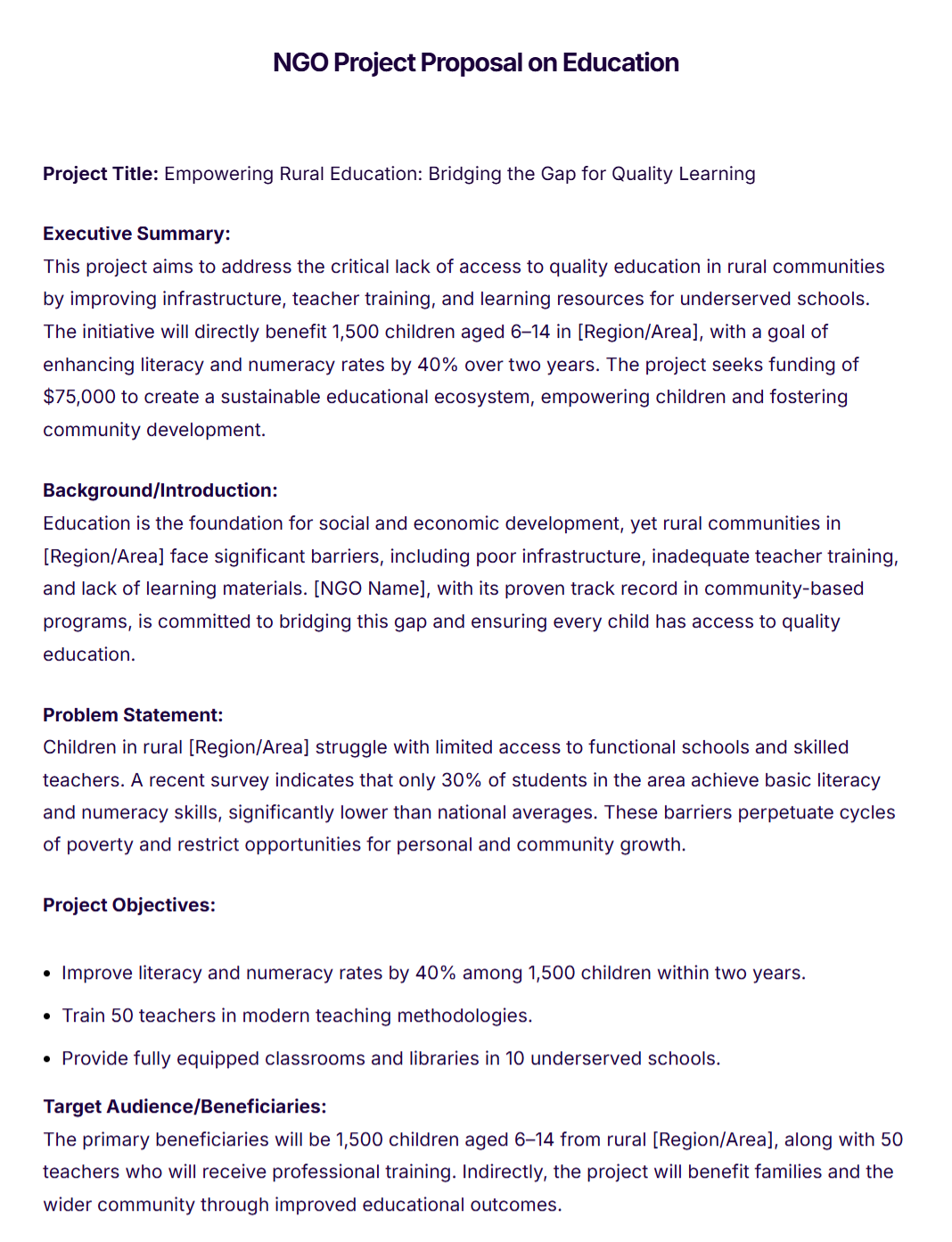
NGO Project Proposal for Funding
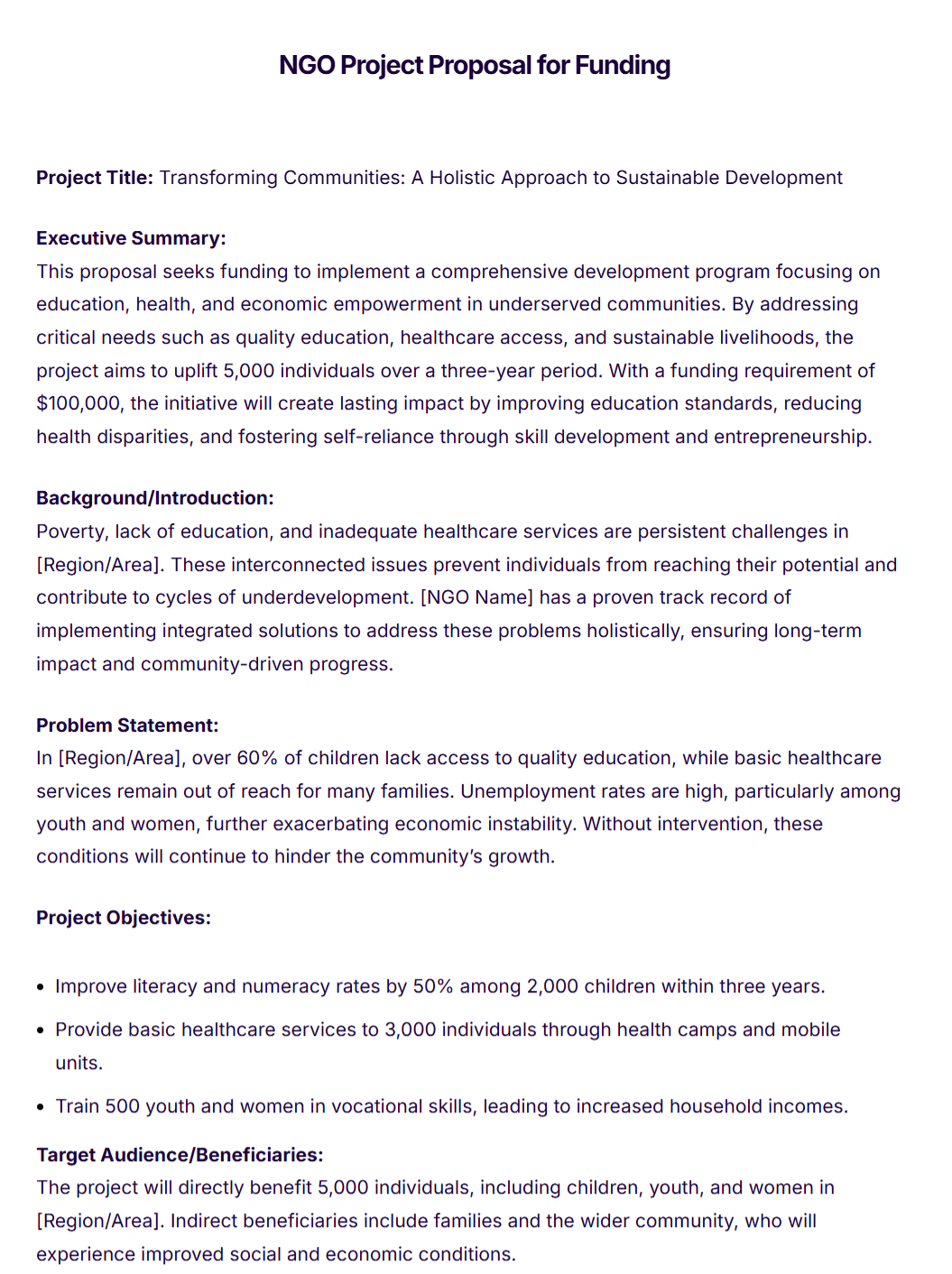
NGO Project Proposal on Health
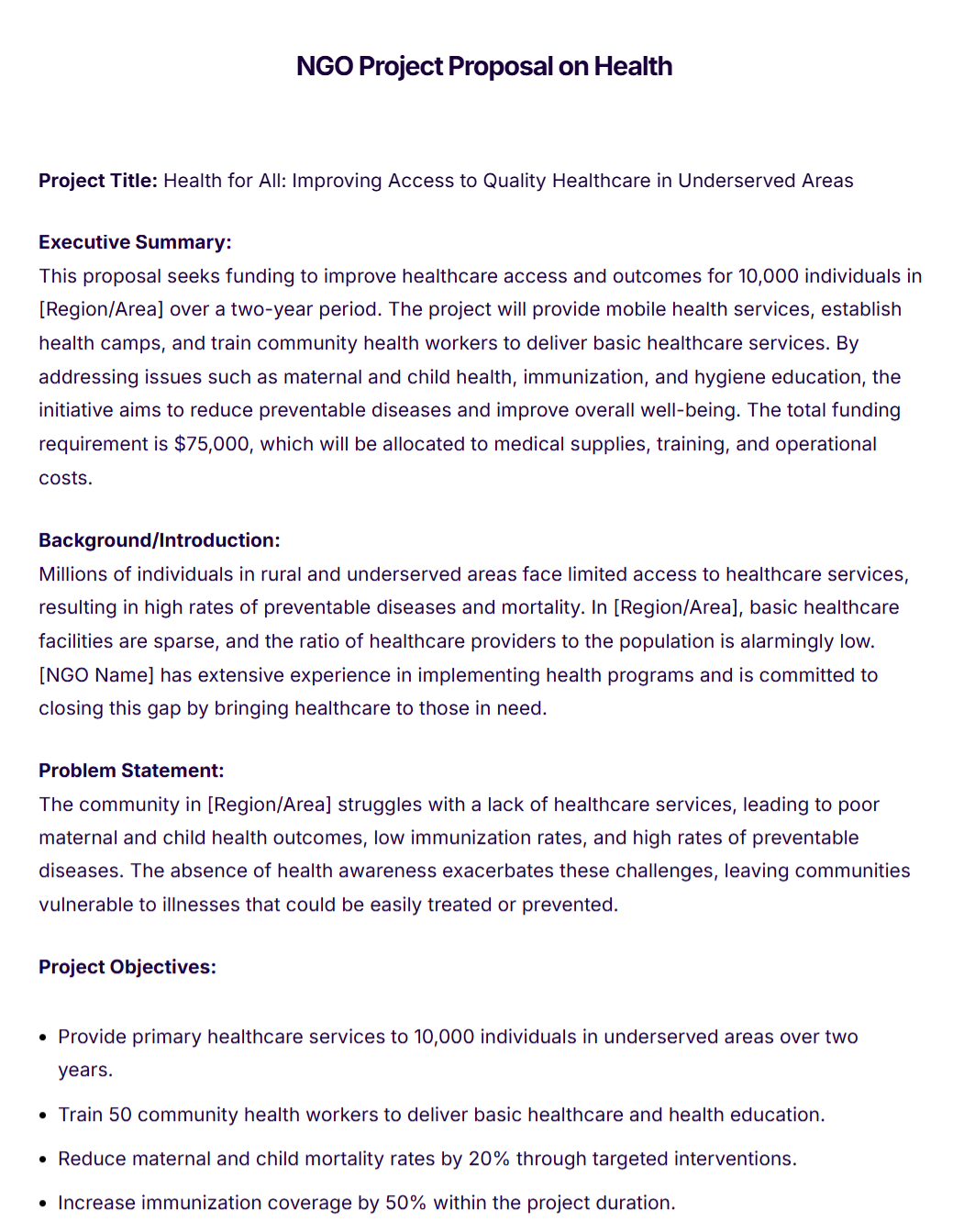
NGO Project Proposal on Agriculture
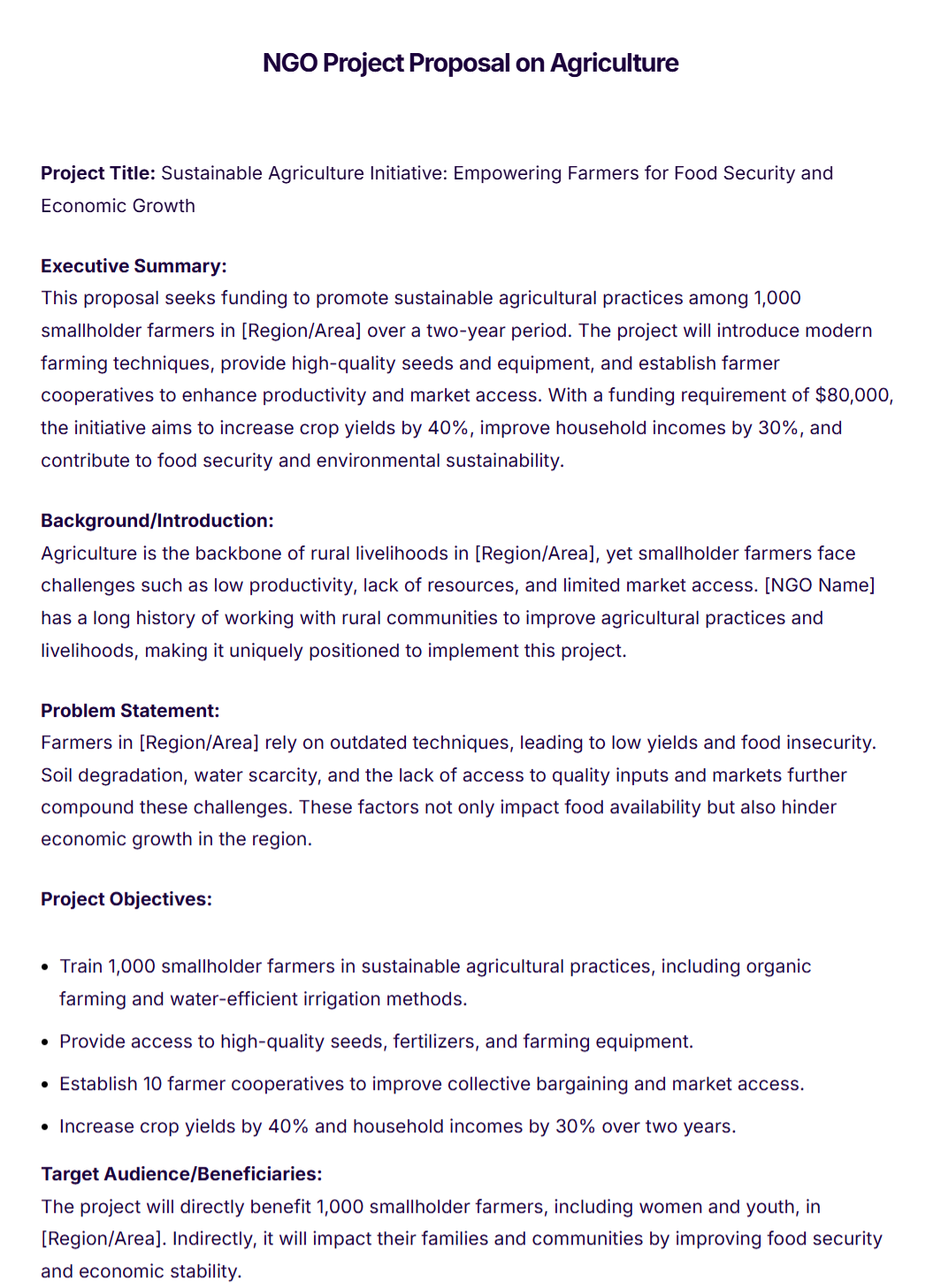
NGO Project Proposal on Women Empowerment
NGO Project Proposal on Environmental Conservation
NGO Project Proposal on Youth Development
NGO Project Proposal on Wildlife Protection
NGO Project Proposal on Disability Inclusion
NGO Project Proposal on Clean Water Access
NGO Project Proposal Templates
1. NGO Project Proposal Template
2. NGO Project Proposal for Education
3. NGO Public Health Project Proposal
4. Sample NGO Project Proposal
5. Proposal for Research Project NGO
Constituents of NGO Project Proposals
Charitable campaigns are organized by various groups of people. And, these groups have their individual roles and responsibilities for the said ventures. Below, you will know the different constituents of project proposals, particularly for NGOs, and their corresponding functions.
1. Proponents – The NGO or NGOs who are responsible for the planning and implementation of the project proposal.
2. Donors – The groups who willingly provide resources to NGOs as supports for the planned and proposed philanthropic activity. There are times that these groups are the one who reaches out to NGOs through donation proposals, nonprofit donation letters, school donation letters, and other donation letter and proposals.
3. Beneficiaries – These groups are the ones who will benefit from the contributions made through the combined efforts of the proponents and donors.
How To Prepare an NGO Project Proposal
Most donors or grantmakers make proposals as their main reference in dispensing their money for a cause. In proposal writing, you need to follow proper formatting. So to save your precious time from researching its standardized flow, we have prepared a ready-made outline of guidelines below that you can refer to.
1. Establish Problem Statement
Problem statement explains the social issues that your proposition is trying to resolve or mitigate. In writing this part, you have to conduct documentary research or provide up to date statistics that your organization has in your data inventory.
2. Present Goals and Objectives
If there is a problem, there is a solution. Since you have firmly established the problem, you should do the same for its way out. Present your resolution in the form of smart goals and objectives. Just like how you justified your problem statement, both your goals and objectives must be based on research. Also, keep in mind to have a SMART goal setting. SMART stands for specific, measurable, attainable, realistic, and time-based.
3. Enumerate Strategies and Activities
There are a lot of ways how you can resolve certain issues. However, the more you focus on one solution, the more likely it will be successful. Plus, a specific and topic-focused proposal is much preferred by donors, grantmakers, as well as sponsors.
4. Set Performance Indicators, Risks, and Assumptions
No professionals want to settle for less. This is why your proposal must also include performance indicators, as well as risks and assumptions that are ready to be evaluated. If all important things have been taken into account, the confidence of your prospective donors, grantmakers, and sponsors on your proposal increases.
5. Results Analysis
In this section, you need to find out what kind of analysis best translates your performance indicators results. For data analysis, you can choose between qualitative research and quantitative research.
6. Draft Monitoring and Evaluating Process
Charitable projects are not planned and implemented at the same time. They have to be performed slowly but surely and monitored thoroughly to ensure effectiveness. Moreover, they don’t end after the charitable activities conclude. NGOs also have to evaluate the overall project. This is why you have to include in your proposal the complete outline of your monitoring and evaluating methodologies.
7. Propose a Budget
All the persuasive facts and data of your proposition all come down to the main purpose of your proposal, which is to solicit for money. You can’t just ask for funds from wealthy and well-educated people without a clear basis. And so, a budget document has to be included in your proposal.
FAQs
How do nonprofit organizations get funding for their projects?
Nonprofit organizations get their funds in four ways, including donations, grants, fundraisers, and direct profits. Donations are the funds that wealthy individuals and organizations give to NGOs to support their charitable cause. Grant budgets, on the other hand, are government-owned funds that are given to organizations, especially those that submitted grant proposals or grant applications, as financial assistance for their philanthropic activities. Fundraisers refer to organized events that generate proceeds, while direct profits indicate the funds that NGOs generate by charging small fees for their programs.
What are the different types of nonprofit organizations?
The different types of NGOs can be classified into two – orientation and operational level. NGOs, according to orientation, consist of charitable, service, participatory, and empowering. NGOs by organizational level are composed of community-based, citywide, national, and international.
What do nonprofit organizations do?
– Nonprofit organizations encourage people to continue striving despite the negativities that are affecting them.
– Nonprofit organizations extend welfare-focused services to people.
– Persuade community leaders to take responsibility of the poor.
– Help local groups to grow.
“The value of man resides in what he gives and not in what he is capable of receiving.” This quote by Albert Einstein is very much applicable to NGOs and donors alike because of their benevolent intentions. However, donors, like most people, want their money spent effectively, so they tend to scrutinize the individuals or organizations that solicit their resources first. An NGO project proposal is the most suitable tool that helps these NGOs in acquiring the financial resources that are much-needed in their philanthropic ventures.


